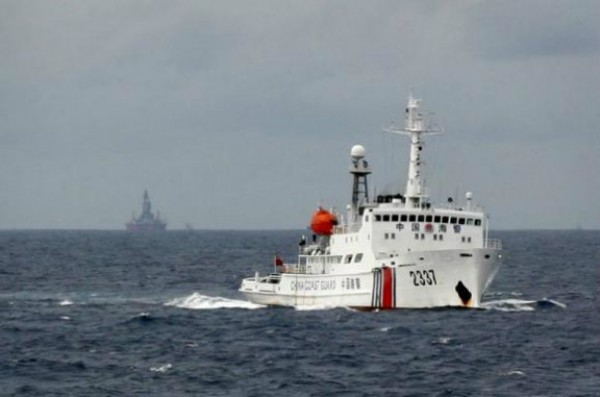Beijing’s Interests In South China Sea Are Beyond Territorial -- Report
| Kristina Fernandez | | Oct 29, 2014 04:59 AM EDT |
(Photo : Reuters / Nguyen Minh) A Chinese Coast Guard vessel (R) passes near the Chinese oil rig, Haiyang Shi You 981 (L) in the South China Sea, about 210 km (130 miles) from the coast of Vietnam June 13, 2014.
China's territorial disputes with its maritime neighbors over the South China Sea is not at all just about regional supremacy, but about oil and natural gas reserves as well, claims a story published by The New York Times Tuesday.
For many years now, China has been embroiled in bitter territorial disputes with countries that form South China Sea's perimeters, including Philippines, Japan, Vietnam, Brunei and Malaysia.
Like Us on Facebook
What appears to be China's attempt at flexing its muscles in the region-and perhaps an open challenge to the United States' influence in the Asia Pacific-is actually a manifestation of its growing interest in the oil and gas pockets hidden beneath the waters' seabed.
This was never more apparent than when Beijing sent an oil drilling rig in the waters claimed by Vietnam earlier this year.
The operator of the rig is no less than China's biggest offshore oil producer, the China National Offshore Oil Corporation (CNOOC).
The move provoked a tensed standoff between Asia's economic giant and Vietnam, and had earned the ire of the rest of the world.
But China came away the winner when it announced in September that CNOOC discovered a substantial gas field off the waters of Hainan-an indication of the country's expanding proficiency in offshore oil drilling.
According to estimates released by the United States Energy Information Administration, South China Sea boasts at least 11 billion barrels of oil and some 190 trillion cubic feet of natural gas.
The New York Times speculates that if these estimates were correct-these include proven and probable cache of oil and natural gas-the South China Sea may rival the oil reserves of Mexico and thus place it among the world's top 10 gas producers.
The energy administration further estimates that the countries straddling the South China Sea were able to produce as much as 1.2 million barrels of oil daily and 3,200 billion cubic feet of natural gas per day in 2011 alone.
These figures nearly equal the total gas produced by Saudi Arabia at the close of 2012 and North Dakota's present oil production.
China, which ranks 1st as the world's largest carbon emitter and whose economy is fueled by industries relying on coal fuels, is pressed by the international community to lessen its production of air pollutants. The New York Times argues that if it could get its hands on the oil and gas reserves of the South China Sea, it could do just that.
TagsEnvironment, Business Finance, Petroleum, Energy, Asia, Territorial disputes in the South China Sea
©2015 Chinatopix All rights reserved. Do not reproduce without permission
EDITOR'S PICKS
-

Did the Trump administration just announce plans for a trade war with ‘hostile’ China and Russia?
-

US Senate passes Taiwan travel bill slammed by China
-

As Yan Sihong’s family grieves, here are other Chinese students who went missing abroad. Some have never been found
-

Beijing blasts Western critics who ‘smear China’ with the term sharp power
-

China Envoy Seeks to Defuse Tensions With U.S. as a Trade War Brews
-

Singapore's Deputy PM Provides Bitcoin Vote of Confidence Amid China's Blanket Bans
-

China warns investors over risks in overseas virtual currency trading
-

Chinese government most trustworthy: survey
-

Kashima Antlers On Course For Back-To-Back Titles
MOST POPULAR
LATEST NEWS
Zhou Yongkang: China's Former Security Chief Sentenced to Life in Prison

China's former Chief of the Ministry of Public Security, Zhou Yongkang, has been given a life sentence after he was found guilty of abusing his office, bribery and deliberately ... Full Article
TRENDING STORY

China Pork Prices Expected to Stabilize As The Supplies Recover

Elephone P9000 Smartphone is now on Sale on Amazon India

There's a Big Chance Cliffhangers Won't Still Be Resolved When Grey's Anatomy Season 13 Returns

Supreme Court Ruled on Samsung vs Apple Dispute for Patent Infringement

Microsoft Surface Pro 5 Rumors and Release Date: What is the Latest?













